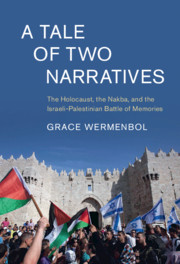Book contents
- A Tale of Two Narratives
- Cambridge Middle East Studies
- A Tale of Two Narratives
- Copyright page
- Dedication
- Epigraph
- Contents
- Figures
- Tables
- Acknowledgments
- A Note on Transliteration
- Abbreviations
- Introduction
- 1 The Post-Oslo Period
- Part I The Textbook of Memory
- Part II The Landscape of Memory
- Part III Scoop on the Past
- 6 Never Forget and Never Again
- 7 Preserving the Past, Mobilizing the Past
- Conclusion
- Bibliography
- Index
- Series page
6 - Never Forget and Never Again
from Part III - Scoop on the Past
Published online by Cambridge University Press: 14 May 2021
- A Tale of Two Narratives
- Cambridge Middle East Studies
- A Tale of Two Narratives
- Copyright page
- Dedication
- Epigraph
- Contents
- Figures
- Tables
- Acknowledgments
- A Note on Transliteration
- Abbreviations
- Introduction
- 1 The Post-Oslo Period
- Part I The Textbook of Memory
- Part II The Landscape of Memory
- Part III Scoop on the Past
- 6 Never Forget and Never Again
- 7 Preserving the Past, Mobilizing the Past
- Conclusion
- Bibliography
- Index
- Series page
Summary
Israel’s leading newspapers – Yedioth Ahronot and Maariv – stand central in this chapter’s exploration of mass mediated Holocaust memories in Israel’s press. Through providing a systematic “cultural seismograph” of annual media content in these outlets on Memorial Day to the Holocaust and Heroism (MDHH) and, subsequently, daily Holocaust output, Chapter 6 evidences a heightened centrality of the Holocaust in the wake of the Oslo Accords. This chapter also reveals an increased contextualization of the Holocaust in line with contemporary societal and political concerns, including those emanating from the ongoing Israeli-Palestinian crisis. Consequently, even outside of MDHH’s ritual media event, the Holocaust remains a newsworthy narrative as it constitutes an effective and powerful prism through which to view the present. Bolstered by the framing of the Israeli-Palestinian conflict in the context of an ongoing threat, part and parcel of the identified prospective memory constitutes a mediated marginalization of the Palestinian Nakba. The final paragraphs of this chapter illustrate the effects of the presentation of an incessant genocidal threat, including at the hands of the Palestinians, by charting the mediated articulation of a superior, “constructionist” Israeli-Jewish victimhood narrative. The explicit allusion to the Nakba within Holocaust media output testifies to an awareness of its formative role among Palestinians, revealing that a minimization of the other’s history is not solely based on its active erasure; rather, the social silencing of the Palestinian Nakba involves debunking the credibility of the narrative and those that externalize it.
Keywords
- Type
- Chapter
- Information
- A Tale of Two NarrativesThe Holocaust, the Nakba, and the Israeli-Palestinian Battle of Memories, pp. 235 - 268Publisher: Cambridge University PressPrint publication year: 2021

